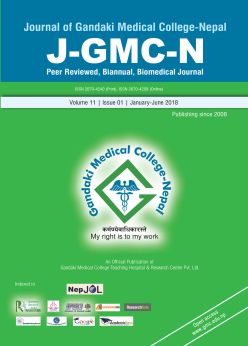Pregnancy Outcome in Women Having Oligohydramnios in Gandaki Medical College Teaching Hospital, Pokhara, Nepal
DOI:
https://doi.org/10.3126/jgmcn.v12i1.22599Keywords:
Amniotic fluid index, Pregnancy, outcome, term pregnancyAbstract
Background: Amniotic fluid index is one of the most commonly used methods of amniotic fluid volume assessment and is a predictor of adverse maternal and perinatal outcome.
Objectives: To compare the maternal and perinatal outcome in women with singleton term pregnancies having amniotic fluid index (AFI) ≤5 cm to those having AFI ≥5 to 20 cm.
Methods: This is a prospective, case-control study which was conducted at Gandaki Medical College Teaching Hospital over a period of one year from July 2017 to July 2018. It included 60 pregnant women at term pregnancy with amniotic fluid index ≤5 cm. The control group included 60 pregnant women at term pregnancy with amniotic fluid index ≥5 cm. The two groups were compared. Statistical analysis was done using the Chi-square test to calculate the P- value.
Results: There was a significantly higher incidence of overall cesarean rates due to fetal distress, low birth weight babies and adverse neonatal outcome like 5 minute Apgar score ≤7, neonatal intensive care unit (NICU) admission rates, and meconium aspiration syndrome in the group with oligohydramnios as compared to the group with normal liquor volume.
Conclusion: Oligohydramnios adversely affects the perinatal outcome. However a favorable outcome can be expected by good antenatal and intrapartum surveillance and neonatal care.
Downloads
Downloads
Published
How to Cite
Issue
Section
License
This license allows reusers to distribute, remix, adapt, and build upon the material in any medium or format for noncommercial purposes only, and only so long as attribution is given to the creator.

